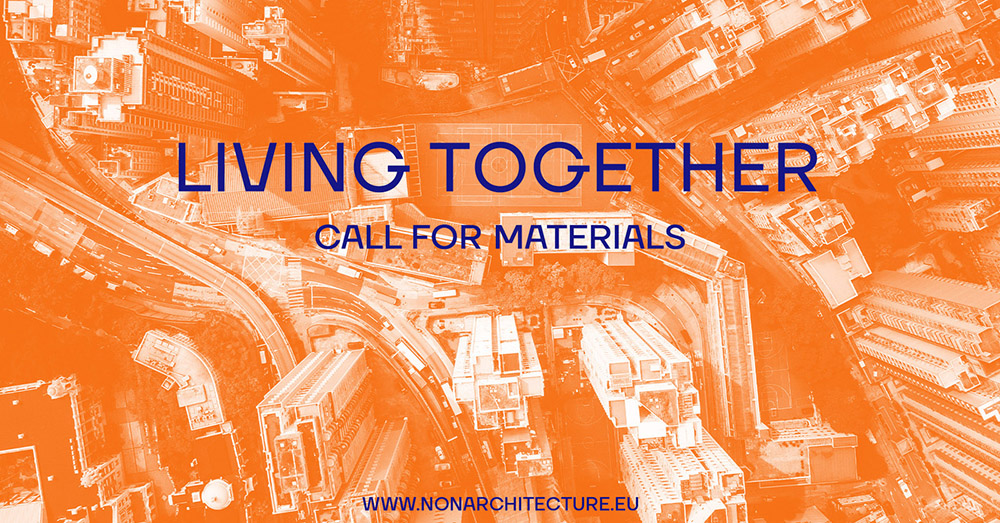Summary: Non-Architecture Competitions aims to find unconventional and unexplored design solutions in the field of architecture. The second phase of competitions is structured in 9+1 themes: a Research Ecosystem with the purpose of exploring each theme from different perspectives. All competitions have their focus on tackling the big issues of tomorrow, by seeking nontraditional approaches in the architect’s work.
We are publishing one book for each theme of competitions where we will compile the best projects but also a series of material that talk about each topic, a Research Ecosystem to create an ongoing conversation.
The Theme One closed on 15 December and the projects from the winners, honorable mentions and editorial picks of the three competitions (48H FLOORPLAN BATTLE, 2020 MONUMENT and FUTURE PUBLIC SPACE) will be included in the book. This call for materials has the purpose to collect relevant contributions regarding this topic and necessary for the book on Living Together.
The aim of the Living Together set of competitions was to develop design proposals that explore this theme from different perspectives.
Description: Every year typically has a few defining moments, but the year 2020 has contained so far, several world-changing and paradigm-shifting developments. This year has become a global milestone, marked with important social and political events: the black lives matter movement, racial unrest, the global refugee crisis, gender equality fight, Brexit, and the COVID 19 Pandemics, all prove that 2020 holds a unique potential to change the world.
A crisis on this scale can reorder society in dramatic ways and all these are world-shattering events whose farranging consequences we can only begin to imagine today. How cities will adapt in reaction to these events, it is the main focus of this research.
History shows the aftermath of world events have brought about radical transformations for societies. Some events only last a moment, others drag on for years, but there are points in history that we can’t help but look back on as signalling a major change in how we live, work, think, and even view other people.
An inclusive society aims at empowering and promoting the social, economic, and political inclusion of all, irrespective of age, gender, disability, race, ethnicity, language, origin, religion, economic, or other status. It is a society that leaves no one behind. Inclusion is ultimately about the dignity and worth of every person, which is the backbone of all human rights.
There is a pressing need to develop societies that embrace diversity and pluralism in the face of the many deep structural inequities and exclusion that persist in countries and regions across the world. Inclusive Society is in line with the United Nations Sustainable Development Goals (SDG) number 1, 4, 10, 11 and 16. While most of SDG might look distant from design, others are directly dependent from it.
The cities diversity has taken a new dimension. In recent years, designers and developers have been encouraged to think more about inclusive cities. Accessible design, usable and inclusive design, and universal design are all approaches to design that can result in products that are easier for everyone to use. Such concepts apply across the entirety of built environment, including not only buildings, transport infrastructure, public space and parks, but also to key products, services and facilities that help improve the experience of urban life. Consequently, opening up the city to all by making it inclusive for all urban residents will involve a wide array of different types of designers, each of whom will benefit from collaborating across disciplines and working with experts in a range of technologies or on designs that extend beyond their traditional spheres of interest.
Making our society more inclusive has both economic and social benefits – but how do we get there? Despite wide recognition and commitment, building inclusive cities remains a challenge. It is time for designers to evolve and develop new shared typologies which move beyond the idea of sharing as a social commodity towards an inclusive culture which values diversity.
Living Together is a compilation of design challenges that aim to promote inclusion in different perspectives.
Guidelines:
The call for materials defines the field of interest of Living Together and produces a context in which to situate contributions.
Contributions can be uploaded in the form of:
/ ESSAY: a brief compositions that describe, clarifies, argues, or analyzes a subject.
/ INFOGRAPHIC: a visual representation of information or data, e.g. as a chart or diagram.
/ PHOTO ESSAY: an account of something told predominantly through photographs, with some accompanying text.
/ ILLUSTRATION(S): a visualization or a depiction of a subject, such as a drawing, sketch, painting, or another kind of image, using a graphical representation.
For more information, download the full competition brief here!


